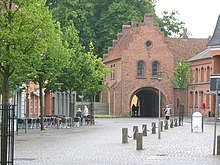Soro
| Soro | ||||
|
||||
| Basic data | ||||
|---|---|---|---|---|
| State : |
|
|||
| Region : | Sjælland | |||
|
Municipality (since 2007) : |
Soro | |||
| Municipality / Office : (until the end of 2006) |
Sorø Kommune Vestsjællands Amt |
|||
|
Harde / Amt: (until March 1970) |
Alsted Herred Sorø Office |
|||
| Sogne : |
Sorø Sogn Pedersborg Sogn |
|||
| Coordinates : | 55 ° 26 ' N , 11 ° 33' E | |||
| Founded: | around 1100 | |||
|
Population : (2020) |
8.005 | |||
| Postal code : | 4180 Sorø | |||
| Sister cities : |
|
|||
| Website: | www.soroe.dk | |||
 Cloister gate |
||||
Sorø is a small Danish town and the administrative seat of the Sjælland region .
Since the municipal reform in 2007 it has been in the municipality of Sorø with a total of 29,881 inhabitants (as of January 1, 2020) and an area of 311.05 km² .
geography
Sorø is on the island of Zealand on the main railway line Copenhagen - Fredericia between Slagelse in the west and Ringsted in the east and is on an "island" in the area of three lakes ; hence the name of the place: Sor Ø means island Sor . The larger lakes are Soro Sø and Tuelsø, Pedersborg Sø is much smaller.
The Sorø train station is located in the district of Frederiksberg, south of Sorø Sø. The railway line to Vedde, just 16 km to the north, with a stop in the Pedersborg district, was closed in 1951.
A section of the E 20 leads past the city not far north . It is 15 kilometers to Slagelse, 16 kilometers to Ringsted, 29 to Næstved , 33 to Korsør , 36 to Holbæk and 80 kilometers to Copenhagen .
history
At the end of the Ice Age , the foothills of the Belt glaciers left numerous lakes in Central Zealand. The nearby town of Bromme gave its name to the first post-glacial Bromme culture . The prehistory of the city is mostly a bit more southerly, in the vicinity of Sorø, where coin finds were also made. The south-flowing Suså , which flows a few kilometers southeast of Sorø and flows into the Baltic Sea at Næstved , was used as a transport route by Lübeck merchants. Along with the Kanhave Canal on Samsø, the Sorø Mill Ditch is one of the most important technical buildings of the Danish Middle Ages. Sorø is around 850 years old. Its forerunner was to the north at the old Pedersborg Castle.
The noble family of the Hvide had their seat in Fjenneslev , 8 km away , where the Danish King Waldemar I (1157–1182) grew up as the foster son of the family. The oldest representatives are "Toke Trylle" and his son Skjalm (Lord of Zealand), who built a wooden church on his farm . In 1151 his son Asser Rig and his brother consecrated a small stone church and founded the Benedictine monastery in Sorø. The monastery Soro was at the instigation of the late Archbishop Absalon already in 1161, the son of Asher rigs by monks from Esrom in a Cistercian monastery converted. Sorø's monastery church, which was started in the same year, is considered to be the most beautiful religious building of the Danish Middle Ages , along with that of Løgumkloster .
The Danish kings Christoffer II (1320–1326), Waldemar IV. Atterdag (1340–1375) and Olaf III are in the city. (1376-1387), as well as the Archbishop Absalon von Lund and the poets Baron Ludvig Holberg (1684-1754) and Bernhard Severin Ingemann (1789-1862) were buried.
Sorø Akademi
In 1586, in the course of the Reformation, the Sorø Academy was established, a Latin school and training center for the Danish aristocracy . In the 20th century, the school enjoyed a high reputation nationwide as a boarding school for the upper classes.
Sons and daughters of the church
- Frederik Sneedorff (1760–1792), historian
- Christian Frederik Lütken (1827–1901), zoologist and paleontologist
- Julius Peter Christian Petersen (1839–1910), mathematician
- Bernhard Laurits Frederik Bang (1848–1932), veterinarian and bacteriologist
- Christian Frederik Knuth (1862–1936), lawyer and master hunter
- Hans Henrikson Ussing (1911-2000), zoologist
- Ann Petersen (* 1966), opera singer
Attractions
- the Bjernede Church is the only round church Zealand and perhaps the most beautiful of the seven received in Denmark.
- the cup stone at Munke-Bjergby , 10 km north of the city
- the dolmen of Døjringe , 7 km north of the city
- the Langdysse and the Runddysse of Vielsted northeast of Sorø
- the Langdysse in Bulbro Skov east of Sorø
- on the A1, about 4 km east of the city, the megalithic complex Barnehøj
- the Ringdysse near Knudstrup or Hylstrup, 6.5 km to the east
- the dolmens at the Kongskilde (king's spring) and the Frederikskilde Langdysse at the north end of the Tystrup Sø (lake)
- the small passage grave Asedysse , also near Lynge-Eskilstrup, 8 km south
- south of Lynge-Eskilstrup the Kellerøddysse , the Dysse with the longest edging east of the Great Belt
- Rune stones , at the Church of Fjennerslev and in the church of Alsted
- nine megalithic systems in or on Broby-Vesterskov , including Broby Mølsøvdys, one of the rare round dolmen.
- four megalithic systems (one with a bowl stone ) and several burial mounds in the forest near Næsbyholm
- Kong Suders Høj a long hill in Topshøj Mark, south of Sorø Sø (lake)
Development of the population
Residents of the city of Sorø (on January 1st)
- 2013 - 7,801
- 2014 - 7,845
- 2015 - 7,754
Individual evidence
- ↑ a b Statistics Banks -> Befolkning og valg -> BY1: Folketal January 1st efter byområde, alder og køn (Danish)
- ^ Sorø-Vedde Banen. Retrieved April 4, 2020 (Danish).
Web links



